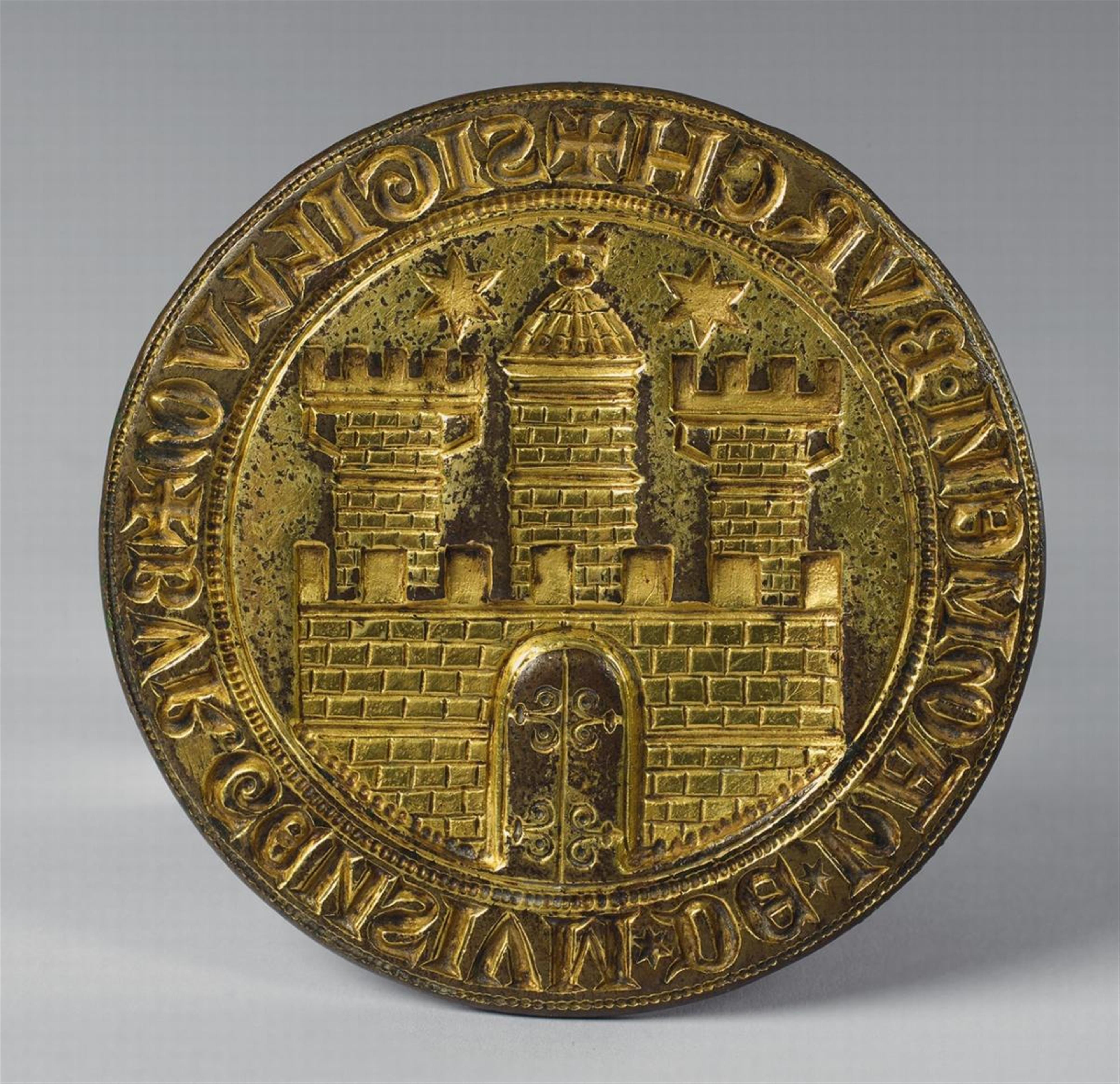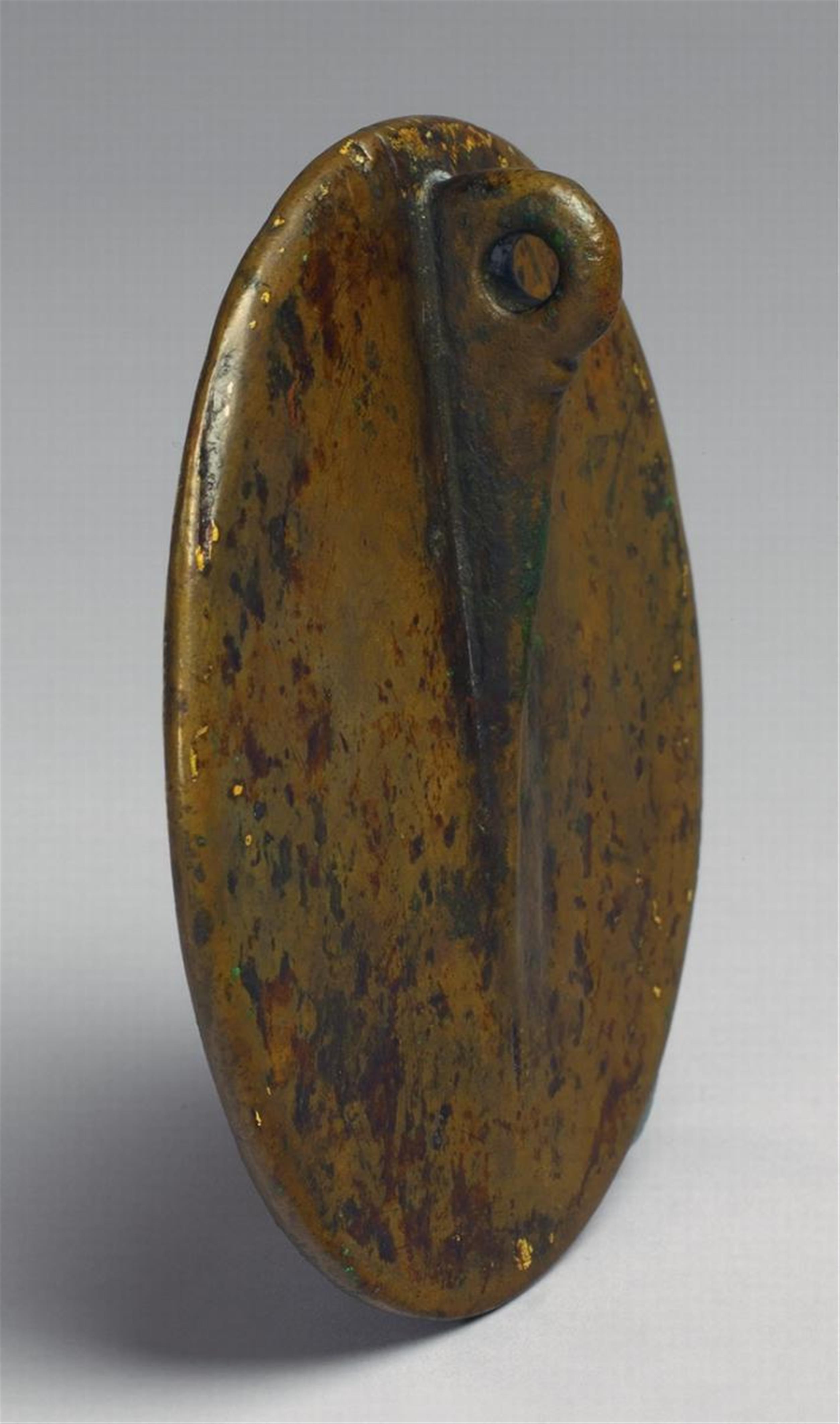Gothic Matrix of the IV State Seal of Hamburg, made in Hamburg circa 1300.
Bronze with remains of fire gilding. The smooth seal plate finely engraved to the recto with a depiction of the state arms of Hamburg and the (mirrored) inscription "+SIGILLVM + BVRGENSIVM * DE * HAMMEN.BVRCH". With a wedge-shaped handle with a small hanging loop to the reverse. In a leather-lined velvet pouch, presumably 18th century, embroidered to the front with the arms of Hamburg between crossed palm fronds..
Diameter 8.9cm..
For half a millennium, from the early 14th to the early 19th century, the IV state seal formed a visible symbol of the independence of the free hanseatic city of Hamburg. This representation of municipal self-confidence did not return to Hamburg following its removal in 1945 and was instead purchased by the current owners at a public auction in 1986. The seal's status as a protected cultural object means that this historic and artistic gem is not permitted to leave the Federal Republic of Germany.
The seal measures just under 9cm in diameter and is an expressive example of medieval goldsmith's craft. Forged in bronze and gilt to the front, the finely carved metal shows a sturdy gate as symbol of the city combined with an elegant inscription and is a worthy representation of the proud citizens of Hamburg. It is also the eldest surviving example of the important metalwork produced in this city at a time when the craft of seal cutting had reached a high level of maturity through the influence of the city's mint. The impressive cast bronze door pull on the western portal of the Church of St. Peter was made significantly later in 1342.
The seal was described as follows in the inventory of the Hamburg state archive's seal collection: “The centre of the seal is round, 89mm across and surrounded by a bead-moulded border; a 68mm field is formed between this and a further double border of bead-moulding and a plain line in which the inscription '+ Sigillum + Burgensium * de * Hammen.burch' begins in the upper left”.
The imposing, windowless castle rests on a circlet of bead-moulding, its iron-fitted gate is closed. A moulded band runs across the centre of the castle wall and it is topped by seven battlements. Three windowless turrets with corresponding moulded bands rise up behind the wall. The outer two of these towers are surmounted by spreading battlements supported to both sides with buttresses, the left with five battlements, the right with four. The central tower, flanked by two six-pointed stars, is slightly higher than the other two and crowned by a conical dome topped by a cross. The small handle to the reverse of the matrix was used to remove it from the wax impression.
“The three towers is the most impressive abbreviation of the city's many turrets” wrote Günter Bandmann in 1951. This simplified image can be interpreted as the city itself, but also as the New Jerusalem. In the 12th and 13th centuries cities were often referred to as castles, and in this image with its central tower surmounted by a cross, we see the city protected by the powers of heaven. This could also be the significance of the two stars above the architecture, for which no other plausible explanation has yet been offered.
„Die Dreiturmgruppe ist sozusagen die eindrucksvollste Abkürzung der Vieltürmigkeit der Stadt.“ So hat dies bereits 1951 Günter Bandmann gesehen. Damit kann Stadt im Allgemeinen, aber auch das Himmlische Jerusalem gemeint sein. Jedenfalls wird die Stadt, die im 12. und 13. Jahrhundert gerne als Burg bezeichnet wird, mit dem mittleren Turm, der hinter dem Burgtor aufragt und mit einem Kreuz gekrönt ist, unter himmlischen Schutz gestellt. Daran mögen auch die Sterne erinnern, für die bisher kein überzeugender Interpretationsvorschlag gemacht worden ist.
Three other seals with a similar depiction of a castle and inscription were known to have predated the present example, the first recorded use of which was 25th December 1304. The earliest impression of the first seal of the citizens of Hamburg is on a certificate dated 1241 securing a treaty with the city of Lübeck. It was not unusual for seals to be redesigned at the onset of a time when power was being exchanged from the city rulers to the citizens. In 1226, the citizens of Lübeck decided upon the use of a seal with a maritime motif based on western models such as those of Paris and La Rochelle, three matrices for which were made pre 1280. The city of Duisburg produced three matrices for their greater city seal before 1360.
Those citizens with primary political control over the city of Hamburg around 1250 mainly originated from the land-owning aristocratic families held in fief by the Counts of Holstein. They decided on a thoroughly different seal motif to Lübeck, and instead of depicting a ship they appropriated the image used on the coinage of the Holstein Counts to whom they owed their allegiance. As of 1239 the citizens demanded that all comital coinage be checked for weight and silver content in order to secure the material foundations of their trade relations. As of 1255 they were granted the right to supervise the minting of coins, in 1293 they had leasehold of mints and finally in 1325 were granted the sole coinage prerogative by the counts. Thus, the image used in the seal reflects a very real political struggle. The use of the city itself as a symbol, for it is in no means intended as a true portrait, is an expression of the citizens' desire for control over coinage as the basis for trade and the development of wealth, and of course over the city itself. In comparison to Lübeck, which was already granted independence as a free Imperial city in 1226, this privilege was afforded to Hamburg relatively late and following lengthy legal and diplomatic disputes. Those in power long shied away from the financial burdens accompanying their obligation to the Emperor, and Hamburg first achieved true Imperial immediacy in 1768/69.
The matrix was originally kept in an iron-mounted box, the whereabouts of which are currently unknown. However, the richly embroidered pouch that provided the seal with additional protection is still extant.
Werner Schäfke, director of the Kölnisches Stadtmuseum, Cologne 29.1.2012.
Provenance
Used as of circa 1300 by the council (senatus) of the free Hanseatic City of Hamburg (the eldest document upon which this seal is found was made on Christmas day in the year 1304, deals with the laying of a road between Hamburg and Lübeck and is kept in the archives of Lübeck). – In 1810/1811 the seal came out of use and was archived in the finance department and then the city archive which later became the state archive. – Lost 1945 after being deposited in a former salt mine near Grasleben. – Sold at public auction in Lower Saxony, confirmed by a high court ruling. – Subsequently on the Cologne art market and later private ownership.
National wertvolles Kulturgut der Bundesrepublik Deutschland.
Literature
On the Hamburg seal in particular cf.: Gaedechens, C. F.: Der freien und Hansestadt Hamburg Wappen, Siegel, Flagge und Cocarde. Hamburg 1855, p. 25. - Hatz, Gert: Die Anfänge des Münzwesens in Holstein. Die Prägungen der Grafen von Schauenburg bis 1325, Hamburg 1952, p. 81. - Eckardt, Hans Wilhelm: Stationen eines Stempels. Historische und archivarische Anmerkungen anläßlich des juristischen Streites um das IV. Hamburgische Staatssiegel, Hamburg 1995 (introductory reading and with further literature). - Weidner, Amalie: Kulturgüter als res extra commercium im internationalen Sachenrecht, Berlin/New York 2001, p. 293ff.
For general reading cf.: Günter Bandmann: Mittelalterliche Architektur als Bedeutungsträger, Berlin 1951, p. 98. - Diederich, Toni: Zum Quellenwert und Bedeutungsgehalt mittelalterlicher Städtesiegel. In: Archiv für Diplomatik 23, 1977, p. 269-285. - Diederich, Toni: Rheinische Städtesiegel, Neuss 1984, p. 217 ff. - Ehbrecht, Wilfried: Ältere Stadtsiegel als Abbild Jerusalems. In: Gabriela Signori (ed.): Das Siegel. Gebrauch und Bedeutung. Darmstadt 2007, p.107-129. - Fink, Georg: Die Lübecker Stadtsiegel. In: Zeitschrift des Vereins für Lübeckische Geschichte und Altertumskunde 35, 1955, p. 14-33. - Gabrielsson, Peter: Die Zeit der Hanse 1300-1517. In: Werner Jochmann und Hans-Dieter Loose (ed.): Hamburg. Geschichte der Stadt und ihrer Bewohner. vol. 1, Hamburg 1882, p. 101-190. - Johanek, Peter: Die Mauer und die Heiligen. Stadtvorstellungen im Mittelalter. In: Behringer, Wolfgang und Roeck, Bernd (ed.): Das Bild der Stadt in der Neuzeit 1400-1800, Munich 1999, p. 26-38 & 428-431. - Wegemann, Georg: Die Brakteaten und Hohlpfennige Lübecks, Hamburgs und Bremens und die Hohlmünzen des Erzbischofs von Bremen-Hamburg Gerhards zur Lippe 1219-1258, Detmold 1956. - Richter, Klaus: Hamburgs Frühzeit bis 1300. In: Werner Jochmann und Hans-Dieter Loose (ed.): Hamburg. Geschichte der Stadt und ihrer Bewohner. Vol. 1, Hamburg 1882, p. 17-100.




